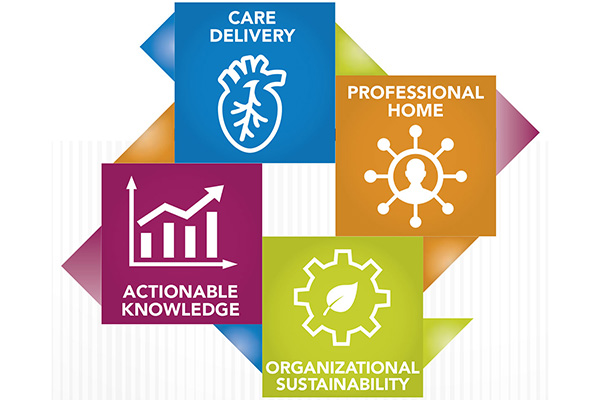Quality Improvement for Institutions | PINNACLE Registry Celebrates 10 years of Quality Improvement

For Sam Kojoglanian, MD, FACC, ACC’s PINNACLE Registry helped him to reach a “new level of interaction” with his patients. Before using PINNACLE, Kojoglanian, an interventional cardiologist, often relied on a primary care doctor for lab results, like HbA1c levels for his patients with diabetes. Once his practice started measuring and tracking patient data through the PINNACLE Registry, Kojoglanian noticed he was missing this vital information for many patients. So he started ordering the lab work himself and reviewing results with patients.
“When I started implementing PINNACLE, it changed the dynamics completely,” Kojoglanian says. “The registry inspired me to get even more involved with my patients. In one year, I saw dramatic drops in my patients’ HbA1c that I’ve never seen because I had been relying on another doctor’s report or relying on my patient’s reports.”
Kojoglanian is one of 8,500 providers in 2,500 practices nationwide who are using the PINNACLE Registry to drive quality improvement. Since its launch a decade ago, the registry has logged more than 45 million patient encounters from more than 10 million unique patients. It is the first registry to examine physician care processes and patient outcomes in coronary artery disease, hypertension, heart failure and atrial fibrillation (AFib) in the outpatient setting.
“The PINNACLE Registry is the first, and now the largest, outpatient registry in the world that is measuring outpatient cardiovascular quality of care,” says Salim Virani, MD, PhD, FACC, chair of the PINNACLE Registry Research and Publications Committee. “I think that once you measure and you provide that data to clinicians they can always work on improving quality.”
According to Virani, research using data from the PINNACLE Registry has evaluated the effectiveness of medications for blood pressure, cholesterol, heart failure and AFib, as well as gaps between guidelines and practice and the impact of new guidelines and treatments on patient care. Other research with registry data has also examined variations in cardiovascular disease care delivery across the U.S.
“A patient who is receiving care in practice A versus practice B should receive very similar care. Care should not vary based on where a patient is going when it comes to guideline-driven care,” Virani says. “I think by measuring quality and providing data back to the practices we will not only improve quality but also decrease variation in care, which should not exist for common conditions.”
"When I started implementing PINNACLE, it changed the dynamics completely. The registry inspired me to get even more involved with my patients. In one year, I saw dramatic drops in my patients’ HbA1c that I’ve never seen because I had been relying on another doctor’s report or relying on my patient’s reports." — Sam Kojoglanian, MD, FACC
Through the PINNACLE Registry, clinicians are able to be on the frontlines of care transformation. “PINNACLE Registry data have helped our practice identify patients at risk with various heart-related conditions and provide solutions, including patient education,” says Trevor Greene, MD, FACC. “The performance measures are equally as valuable because they compare standards of specific classifications to the national average, directing our practice to strive beyond the national average.”
Quarterly benchmark reports allow practices to track progress over time and identify areas for practice-level improvement. For example, over the years, PINNACLE Registry data have shown that while the vast majority of providers regularly record patients’ blood pressure, fewer than half report developing hypertension treatment plans. For clinicians like Kojoglanian, this is a prime area for improvement.
Before joining the PINNACLE Registry, Kojoglanian sometimes let high blood pressure readings slip by when patients said they had a stressful day. But now he advises all patients with hypertension to check their blood pressure twice a day and send weekly reports. As with HbA1c, he also saw a dramatic drop in hypertension. “Small details are no longer falling through the cracks, and that has improved my care for my patients, which has improved their health significantly,” Kojoglanian notes.
Preparing For a Changing Landscape
Over the past decade, the PINNACLE Registry also has helped to address many of the myriad challenges facing cardiovascular practices, including emerging value-based reimbursement models, the continued trend toward integrated practices, and the rise of new, untested business arrangements.
For example, clinicians have been able to leverage the PINNACLE Registry to submit data on their behalf to the Centers for Medicare and Medicaid Services (CMS) for the Physician Quality Reporting System (PQRS), and more recently the Quality Payment Program (QPP) developed under the Medicare Access and CHIP Reauthorization Act of 2015 (MACRA). For the 2017 QPP reporting year, the PINNACLE Registry submitted data for more than 1,600 eligible providers.
For Centra Health Cardiovascular Services in Lynchburg, VA, PQRS reports from PINNACLE were critical when the practice merged with a larger health system 12 years ago. Initially the practice and health system were on different electronic health record (EHR) systems and it was difficult to merge the data. Because the practice had been using the PINNACLE Registry to track PQRS measures, however, the health system accepted the PINNACLE Registry PQRS reports in place of EHR reports, says William Price, MSN, MBA, NP-C, managing director of strategy and operations for Centra’s Stroobants Cardiovascular Center.
"A collaborative care model whereby physicians and advance practice providers work together to take care of a large number of patients doesn’t decrease the quality of cardiovascular care that is provided … it definitely improves efficiency because physicians can then concentrate on some of the more acute needs of their patients with cardiovascular diseases." — Salim Virani, MD, PhD, FACC
Being able to use the PQRS metrics instead of the health system’s internal quality metrics made the transition easier for the providers, Price adds. “They knew we had worked hard to make sure the PINNACLE Registry data were vetted and thorough and coming from a good source.”
Today, Centra continues to use PINNACLE Registry reports to show how the practice is performing against the national average. “Being a competitive group, our cardiologists always want to see our line against the benchmark,” Price says. “It is motivational when we can say we’re not performing above our peers on this measure or we’re knocking it out of the park in this area.”
As the health care landscape changes, practices are finding new ways to be efficient in care delivery without compromising quality. A 2015 study, published in the Journal of the American College of Cardiology, used PINNACLE Registry data to assess whether the quality of care provided by advanced practice providers (APP), such as nurse practitioners and physician assistants, was comparable with care provided by physicians. The study found no difference in care delivered by APPs vs. physicians for coronary artery disease, heart failure and AFib.
“A collaborative care model whereby physicians and advance practice providers work together to take care of a large number of patients doesn’t decrease the quality of cardiovascular care that is provided,” says Virani, who was the lead author for the study. “But the flip side is that it definitely improves efficiency because physicians can then concentrate on some of the more acute needs of their patients with cardiovascular diseases.”
Looking Ahead: The Next 10 Years
After a successful first decade, the PINNACLE Registry will look at new ways to improve outpatient cardiovascular care. Plans are already underway to expand the registry’s scope over the next year to include patients with pediatric and adult congenital heart disease. In addition, the registry is exploring expansion to include potential new clinical areas of renal function and renal cardiology, lipid management and obesity/weight management.
Going forward, Virani expects to see the PINNACLE Registry expand its international presence. In 2012, the ACC launched the PINNACLE India Quality Improvement Program, which uses the PINNACLE Registry’s platform to address the increasing cardiovascular disease burden in India and help clinicians practicing in India evaluate the quality of cardiovascular care their patients receive. Data from the PINNACLE India program has already led to several published papers examining the quality of cardiovascular care in India.
“We’re taking the best practices from what we have learned in the U.S. and trying to see if this strategy of providing data back to clinicians can work in other countries,” Virani says. “I think taking the PINNACLE Registry into the international space is a strategic aspect of how we’ll look at the registry in the next 10 years.”
With its wealth of data, the PINNACLE Registry also will continue to be a source of real-world data to measure the impact of new guidelines and treatments in the U.S. Virani predicts researchers will look at innovative ways to use “structured” data, or specific measurements, in patient records to drive quality and also start looking beyond structured data.
According to Virani, the “unstructured” data, or text notes, in EHRs can provide a deeper understanding of what might be influencing quality of care. In addition, as the ACC increases its focus on improving population health, Virani predicts future research will look at how social determinants of health – like education and income level or where a practice is located – affect patient outcomes.
As the PINNACLE Registry continues to amass encounter records, another new research avenue is possible precisely because the registry looks at outpatient care. Unlike inpatient registries that cover a single hospital stay, the PINNACLE Registry provides an opportunity to follow a patient’s care longitudinally over several years. This gives investigators the ability to look at care delivery across multiple visits and track patients over several years.
Along with that, Virani notes that linking PINNACLE Registry data to NCDR inpatient programs could show care delivery and transitions across inpatient and outpatient settings. This would enable researchers to follow patients when they are admitted to the hospital through NCDR’s inpatient registries and then continue to track them through the PINNACLE Registry.
“Care doesn’t stop when a patient is admitted to the hospital with a myocardial infraction (MI),” Virani says. “Care continues in the outpatient setting. A lot of prevention of second or third MIs happens in the outpatient setting, so I think there is going to be more of a push toward looking at that.”
As the PINNACLE Registry looks forward to the next decade, Virani notes it’s a good time to remember the people who helped build the registry. “At the end of a decade of some great work, I think we should thank those volunteers and staff members who continue to invest their time and effort to make this registry worthwhile for clinicians, patients and investigators.”
Clinical Topics: Arrhythmias and Clinical EP, Prevention, Atherosclerotic Disease (CAD/PAD), Atrial Fibrillation/Supraventricular Arrhythmias, Hypertension
Keywords: ACC Publications, Cardiology Magazine, Coronary Artery Disease, Atrial Fibrillation, Glycated Hemoglobin A, Quality Improvement, Diabetes Mellitus, Hypertension, Primary Health Care
< Back to Listings







